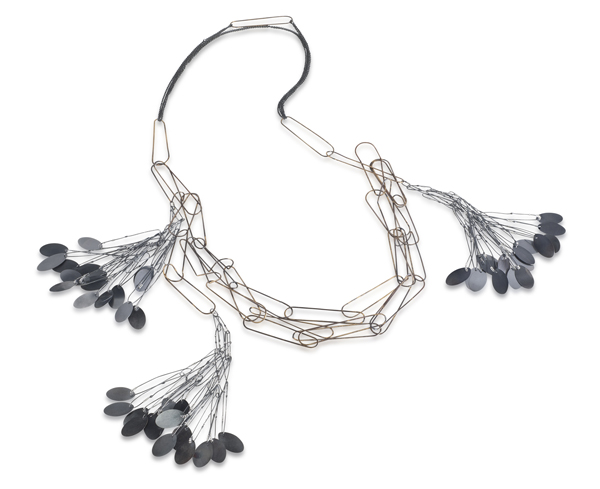
Missy Graff: Please tell me about your background. Have you always had an interest in making jewelry?
Amy Tavern: I began metalsmithing in 1998. Before that, I was interested in music and went to college to study opera. I switched majors early on and got a degree in arts administration instead. In my senior year, I took a series of visual art classes and began to discover a different kind of creativity, especially through my ceramics and sculpture classes. I had been curious about jewelry for a long time, and I had been making beaded jewelry in my free time since high school.
As I took more art classes, I started thinking about jewelry as small-scale sculpture. Jewelry and metalsmithing were not offered at my school, but I promised myself I would learn one day. A few years later, I began private lessons with Barbara Crocker in Great Barrington, Massachusetts. I worked with her for a year and built my portfolio. Then in 2000, I relocated to Seattle and began a post baccalaureate program at the University of Washington with Mary Lee Hu. I graduated with a BFA in 2002 and started my business immediately after. I did production work for several years, and in 2009, became a resident artist at Penland School of Crafts in North Carolina, where I spent three years developing my one-of-a-kind work. Since then, I have been working in my studio and traveling a lot for residencies, exhibitions, and teaching.
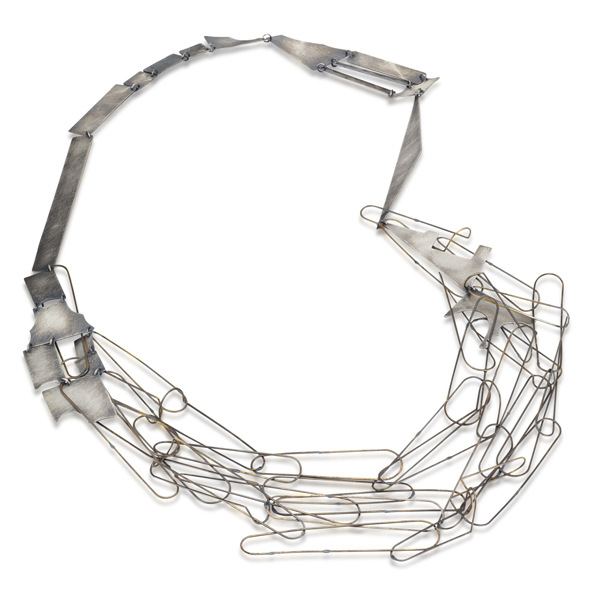
Can you please explain the concept of Parallel Constellations?
Amy Tavern: Parallel Constellations centers on constellations and the night sky, mapping, connections, conversations, and the friendship between Raïssa and me. A while ago, when I was preparing to leave the country, Raïssa described a dream she had about the night sky and understanding or feeling distance in a new way. In her dream, the sky became a constant, something familiar and comforting in the unknown. We talked about the sky always being the same wherever you go. While I was away in Europe, Raïssa and I would deliberately look at the night sky and think of each other. I would meditate for a few moments as I looked at the same moon, the same stars, and the same constellations that she was looking at. Even though the spaces between us and the things we were doing seemed ever changing, the sky and the stars remained the same, and perhaps this consistency parallels our friendship. It was always interesting for me to think about this. I also couldn’t help but feel distance in a new way when I was separated from everything I was familiar with.
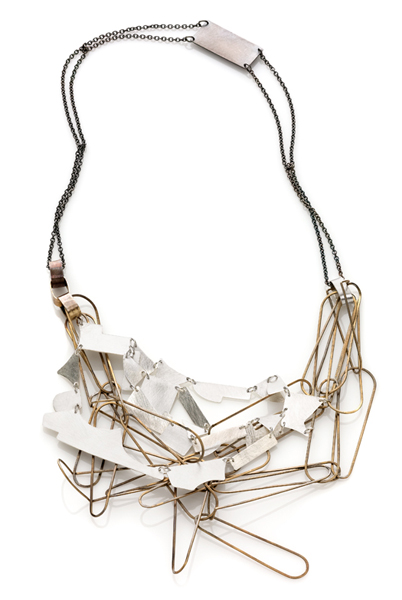
Raïssa Bump: The concept of a constellation is very interesting to me. You really must use your imagination to see what it is that others are describing. A constellation can be a group or cluster of related things. It is arbitrary. Constellations are about perception and finding ways to make sense of what is around us, which is essentially what a map is. When I think of parallel, I think of two lines running continuously at equidistance. The concept also references something occurring at the same time or in a similar way.
When Amy and I began focusing on this exhibition, we did what we always do—we shared stories and conversations about dreams, distance, symbols, place, friendship, adventure, memory, space in-between, time, the night sky, the sky in general, connecting the dots, chains, links, maps, mapping, opposites such as discomfort/comfort, traditional/atypical, sensitive/tough, new/old, familiar/unfamiliar, chaos/focus. We talked about Amy. We talked about me. When it was time to title the exhibition, the combination of those words felt right.
While working on these pieces, one memory that crossed my mind often was of an experience I had when I was abroad as a young teenager. I remember having the incredible feeling that the only things I was connecting to in a familiar way were the stars above.
Why did you decide to collaborate? Do you think this collaboration changed the way you work?
Amy Tavern: We decided to collaborate because of our friendship and the camaraderie we have as colleagues. We were both open to new ways of working and new ideas for exhibitions. We talk a lot about work, business, and life. The conversations are always very natural and honest. Our time apart has been far greater than the time we have spent in the same place, and we have had to work at staying in touch. Miles have always separated us, but our friendship has developed over the years into a close bond despite the distance. I think collaborating was a natural extension of this development and our relationship. I had a good feeling about it from the beginning and knew the process would be challenging, stimulating, and inspiring. I also knew it would be a meaningful way to honor our friendship and the respect we have for one another as artists.
This process didn’t change the way I work, but it did help to shift my perspective on collaborating. I haven’t done a lot of collaborating apart from some really small projects. I prefer working alone in my studio and working on my own ideas, but I was immediately open to working with Raïssa on a project when the idea came up. Since working with her, I have found I want to collaborate more and more often and with artists from different fields.
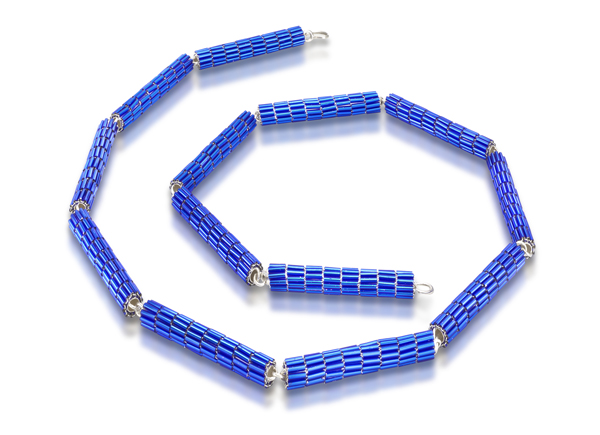
Collaborations can be many things. While there are six necklaces that Amy and I literally collaborated on, we each created our own bodies of work. Before we began making, we had conversations about overarching themes that sparked both our curiosity and interest. However, we worked privately and independently. We used materials and techniques that relate to our own work. Apart from seeing the collaborative pieces, we did not see what the other person was working on until most of the pieces for the exhibition were finished.
For me, the way I work did not have to change just because I was collaborating with someone else, and I feel that is part of why it has been an enjoyable process. I did get a taste of a more structured, organized timeline, having to hash out much of the roadmap even before beginning.
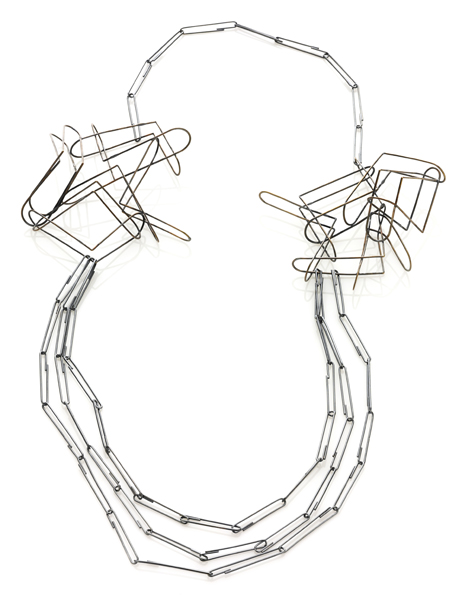
Amy Tavern: I used many of the devices I am comfortable with, such as multiples, repetition, texture, negative space, and visual movement, and I combined them to create a balance of the rough and refined. I established a few elements that represent aspects of our concepts and used them from piece to piece. These forms are reminiscent of forms I have used in previous work and echo my interest in mapping, memory, and sentiment. I love working with brass right now, and I used it a lot for my part of the collaborations as well as other pieces in the show.
Raïssa Bump: I am not easily tied down to one style, but I feel that my voice and my hands have left their mark, though the thread that joins may be subtle. My style is not uniform, but it can be identified. Some of the “me” you can find in the collaborative pieces includes: my love of sparkle or how light hits various surfaces; the use of the same color in several materials; repetitive and tedious handwork that becomes a meditation to me; and repurposing my own scraps to create new works. Some of my work may seem awkward, yet if you put it on, it can be surprisingly beautiful and wearable. The pieces can even make you feel a way you never knew you wanted to feel.
Describe the pieces that you exchanged. What was the process like? Which piece do you feel was most successful?
Amy Tavern: I found the process to be open and generous. There was a helpful structure, but occasionally the process felt daunting or a bit strange. We planned the timing, working with the limitations of each other’s schedules. We decided to exchange the work once—I would make half of a piece and send it to Raïssa to finish; she would make half of a piece and send it to me to finish—and we tried to mail our pieces at the same time so we were always working in tandem. We kept each other’s pieces intact and added to them with our own elements in whatever way we wanted. It felt a little strange sometimes, because essentially, I was completing someone else’s thought. I also experienced some pressure because I wanted to do right by this person I care about and respect. The entire process was really quiet lovely, a good mix of ease and challenge.
My favorite collaborative piece is Maps: Upland. I think this piece is the most successful because it is clearly the work of two people with an area of overlap where the elements meet. It was also the one I was most excited about working on. I remember specifically how excited I was when I opened the box from Raïssa.
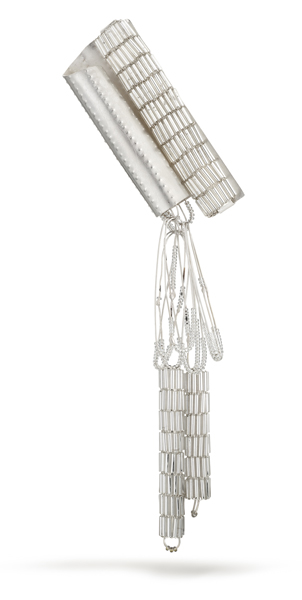
I had the most immediate, visceral response to Maps: Upland when I took it out of its wrapping. It was a wave of good feeling. I put it on, and it made that day. I had sent Amy a long length of chain that was made entirely from scraps of my sheet metal. Although they are linked together with movement, the piece has a visual stiffness and solidness. It feels very structural. Amy added light and airy links that overlap and cascade down from it. To me, the necklace is having a dialogue with itself and has a successful visual balance, clarity, and ease.
Have you collaborated with other jewelry artists in the past?
Amy Tavern: No. This is my first foray into collaborating with another jewelry artist. I have done a few very small projects with a glass artist, an illustrator, and a bead artist, but never a jeweler.
Raïssa Bump: Never. It may not happen again, then again, it just might. Either way is OK by me.
What I really enjoy is embarking on different projects and seeing what I can create. The elements that make up an exhibition (the where, the who, the time, my current materials, and techniques of interest) create the opportunity for diverse bodies of work and different insights to be gained. I am a hands-on thinker and processor, and I surprise myself with what I create. I don’t know where I am going until I am there, although I make decisions the entire way. Some ideas have to percolate for years before the “right” project presents itself, and pieces are made. I saw this collaboration as a tool that propelled me forward into uncomfortable and uncharted territories, and I ended up somewhere on the other side. Somehow, I crave this kind of process.

Why did you decide to present this exhibition at Gallery Lulo? Did the gallery approach you, or did you reach out to them with a proposal?
Amy Tavern: Two years ago, Raïssa and I visited Gallery Lulo to meet Karen Gilbert and Katrina Schjerbeck for lunch. I had never been to the gallery before. I wanted to see it and get to know my gallerists better. Raïssa and I drove to Healdsburg, California, for the day. During lunch with Karen and Katrina, we talked about exhibitions. If I remember correctly, the topic of the “how” came up, and Karen and Katrina said they liked it when artists suggested ideas for shows. I remember Raïssa and I looking at each other, and then turning to Karen and Katrina and saying, “We want to do a show!” They said yes, and that was it. We started working out the details a few months later, decided on the dates, and then began developing the concept in January 2013. Karen and Katrina were open to our ideas and gave us lots of room to do what we wanted. I was interested in working with Gallery Lulo because Karen and Katrina are wonderful to work with, and the gallery is beautiful. I like having a relationship with my gallerists and always like working with people I admire and connect with.
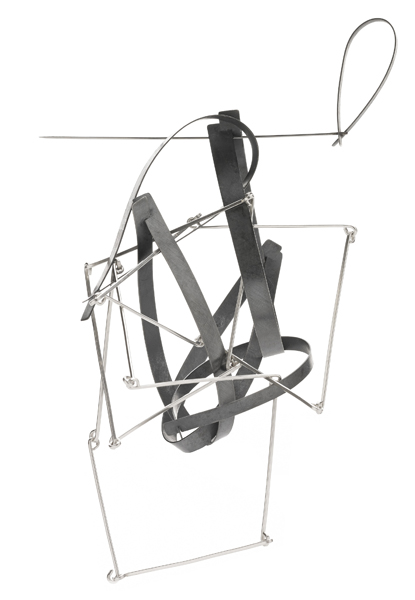
What would you like your viewers to take away from this show, besides beautiful pieces of jewelry?
Amy Tavern: I really hope people can see our friendship in the work. Raïssa and I have a wonderful, lovely, and easy way about our relationship. There is a balanced give-and-take when we interact, and I always feel inspired or excited as our conversations progress. I admire Raïssa as a person and as an artist. I hope people can see the level of care and understanding that exists between us. I also hope people can see the commitment we have to our work and art practices.
Raïssa Bump: It is great when pieces find homes! Beyond that, I hope viewers take a conversation with them, and that one of the pieces, or part of a piece, triggers a memory that was long forgotten, questions their idea of beauty, or that something inside of them shifts. I would like for the viewer to share what they experienced with someone else.
Please describe the most interesting exhibition you have seen lately.

Raïssa Bump: Although the American landscape is not an exhibition at all in the traditional sense, I spent most of the past month on the road with my boyfriend and our dog, and I can’t get the landscape out of my head. It is vast and varied, familiar and foreign, inviting and repelling. During that time, I had no interest in galleries or museums. The light and the landscape filled me up and settled in on a vibrational level, just like a great piece of art can.
What are you reading?
Amy Tavern: The Book Thief by Markus Zusak, Did You See Me? by Sophie Calle (for the second time), various bits and pieces and essays about Gabriel Orozco and Ólafur Elíasson on the Internet, some poetry by Seamus Heaney, and the September issue of Vogue.
Raïssa Bump: I recently finished an immediately engaging book, When Women Were Birds, by Terry Tempest Williams. It is about place, voice, and family. Now I have a book of poetry written by my namesake Raïssa Maritain. It is the first time that I am reading her poetry, and I’m thinking about my parents and their interests around the time I was born. An ongoing reference book that I use is The Book of Symbols: Reflections on Archetypal Images. I also enjoy re-reading a short book of essays titled On Looking by Lia Purpura.
Thank you.





